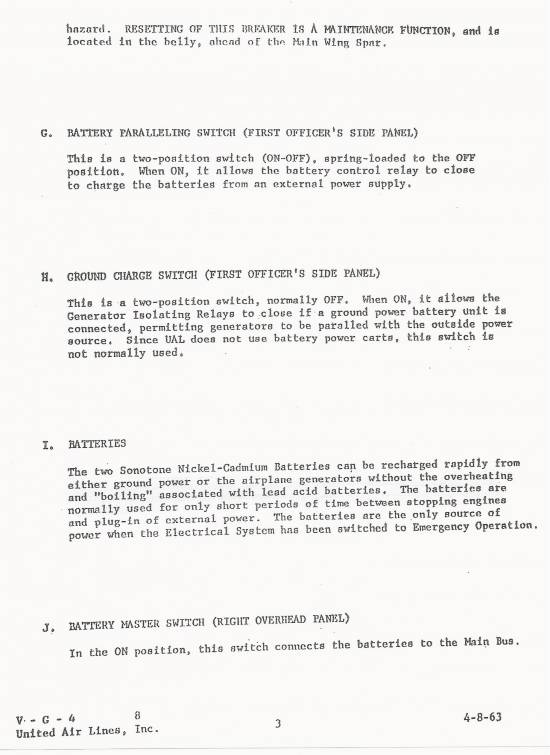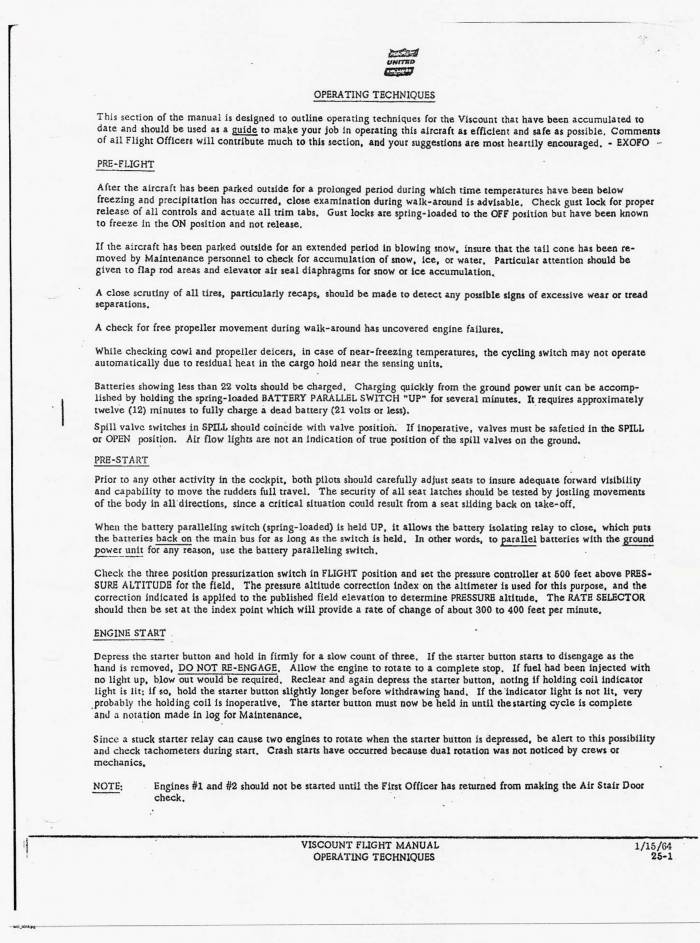Vickers Viscount 745D, N7405, July 9, 1964
FAA Advisory Circular AC 00-33A
From the Civil Aeronautics Board Report, Page 1 and Page 2:
History of Flight
The aircraft, N7405, operated as United Air Lines (UAL) Flight 609 from Raleigh-Durham, North Carolina, to Philadelphia with intermediate stops at Washington, D.C., Buffalo and Elmira, N.Y., and Williamsport, Pennsylvania. The aircraft departed Raleigh-Durham at 0705 (EST) and arrived at Philadelphia at 1245 (EST). The captain and senior stewardess from Buffalo to Philadelphia stated that the flight was routine and the aircraft operated normally.
The captain, first officer, and one stewardess served aboard UAL Flight 662 from Washington, D.C., to Philadelphia, arriving at Philadelphia at approximately 1215.
United Air Lines Flight 823, a Vickers Viscount 745D, N7405, departed Philadelphia at 1513 arriving at Washington, D.C., at 1554. No discrepancies were reported by the crew at Washington and no maintenance, other than servicing, was required or performed prior to departure for Knoxville.
Flight 823 was a regularly scheduled domestic public transportation flight from Philadelphia, Pennsylvania, to Huntsville, Alabama, with intermediate stops at Washington, D.C., and Knoxville, Tennessee. Flight 823 departed Washington, D.C., at 1636 with an estimated arrival time of 1813 at Knoxville, Tennessee.
The same aircraft (N7405) that was to later serve as UAL 823, began the day of July 9, 1964 as UAL Flight 609. It appears that a different captain and senior stewardess served on board Flight 609 between Buffalo and Philadelphia, and were not part of the original crew who began Flight 609's operations that day at Raleigh-Durham. In all, two separate crews served on board N7405 while it was classified as United Air Lines Flight 609. UPDATE From Knoxville News-Sentinel January 14, 1965: “Captain Samuel Huntington headed the crew that flew the plane from Buffalo to Philadelphia. Stewardess Betty Jones also worked the flight.”
In the second paragraph, mention is made of “the captain, first officer and one stewardess” arriving in Philadelphia; after having served on board United Airlines Flight 662 taking off from Washington, D.C. I'm assuming the people mentioned include Captain Sabatke, First Officer Young and one of the stewardesses-all of whom would later that same day serve on Flight 823.
The four Rolls Royce Dart 510 engines that powered N7405 were started a total of seven times that day; beginning in Raleigh-Durham. The aircraft's engines were started before subsequent takeoffs from Washington, D.C., Buffalo and Elmira, N.Y., Williamsport, PA, Philadelphia, and, for the last time, in Washington, D.C.
FAA Advisory Circular AC 00-33A , dated 2/14/1973, in Section 5a mentions frequent engine starts as a factor that can cause battery overheating.
Advisory Circular AC 00-33 , dated 8/26/71, in Section 4c also listed frequent engine starts as a cause of battery overheating.
Engine starts, after short duration flights, were performed seven times on July 9, 1964.
Both Advisory Circular AC 00-33 and FAA Advisory Circular AC 00-33A (published in 1971 and 1973 respectively) state in BACKGROUND: “An increasing number of potentially hazardous incidents involving nickel-cadmium batteries, during flight and ground operations have been reported. The failures are more prevalent where the batteries are charged directly from the DC bus rather than by a separate battery charger…”
In the United Airlines Viscount Pilot Program, dated 4/8/63:
Section I BATTERIES The two Sonotone Nickel-Cadmium batteries can be recharged rapidly from either ground power or the airplane generators without the overheating and boiling associated with lead-acid batteries…“
Section G, regarding the Battery paralleling switch: This is a two position switch (ON-OFF), spring loaded to the OFF position. When ON, it allows the battery control relay to close to charge the batteries from an external power source.

Advisory Circular AC 00-33 in Section 5e recommends that ni-cad batteries not be charged in the aircraft by a ground power unit. This section refers to Section 7a where it states “charging ni-cad batteries with a constant voltage ground power unit is not recommended in as much as this eventually results in cell imbalance and gradual reduction in battery capacity.
All advisories and airworthiness directives warn of the dangers of extreme heat surrounding the batteries-especially during ground operations. References are made to the “ambient temperature”. Inadequate ventilation of battery compartments is given as a possible cause of thermal runaway.
July 9 was a typical hot summer day on the ground.

